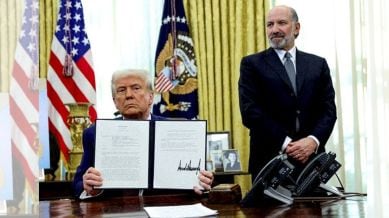The two big unknowns post that are: What these tariffs are going to be like and, more importantly, who’s going to retaliate and by how much?
If the approach taken by countries so far is anything to go by, the principle of calibrated, moderate hikes on critical goods that clinically impact American consumers could be a favoured model. This is especially so, since these reciprocal tariffs are not likely to be an end in themselves, and more of a stepping stone for a grand bargain.
America’s tech exports may be targeted by Brussels
The European Union has, so far, hit back against Trump’s earlier announced tariff hikes on steel and aluminium by taxing key US product imports, from Harley-Davidson motorcycles to bourbon. The focus so far, though, has been on goods trade. What seems to have been ignored is Washington, DC’s considerable export surplus on the services side, especially to markets such as Europe. In January 2025, for instance, while America’s goods trade deficit increased by $33.5 billion to $156.8 billion, its services sector recorded an increase in the surplus of $0.2 billion to $25.4 billion.
There is a possibility that the EU could go ahead with some retaliatory curbs on digital services coming in from the US, which could potentially open up a whole new front on this trade war. Bilateral trade deficits are a lot more than just factory goods and a digital onslaught, in some punitive manner, could end up impacting Meta, Alphabet and other companies that are at the heart of the American innovation story and have led the bull run in US stocks over the last 12 months. A hit on these services by Brussels could be troublesome for Washington, DC., since European regulators are already scrutinising Apple and are taking a close look at Meta’s practices, among other major American companies that are in the regulatory crosshairs across the Atlantic. That could trigger a Black Wednesday for the American stock markets, as some have predicted.
Chinese countermeasures driven by clinical targeting
Responding to tariff impositions in Trump’s last term, China’s retaliatory measures largely consisted of tariffs slapped across a wide range of American imports before the two sides reached a “phase one” trade deal. This time around, Beijing has been far more tempered, and has, instead, moved more strategically. So far, it has hit back swiftly on the two tranches of additional 10 per cent tariffs Trump imposed on Chinese imports to the US, while readying a toolbox of other countermeasures.
China has specifically targeted American farm goods, including soybean and pork, that could impact Trump’s agri support base in the American midwest. Soybean is the largest agricultural export to China from the US.
Story continues below this ad
Late last year, the Chinese government also overhauled its export controls for “dual use” items and then swiftly tightened the export of gallium, germanium and antimony — key elements with tech and military applications.
Comparatively positive outlook for India
India looks to be in a comparatively advantageous position, though Trump has repeatedly flagged the high tariffs imposed by New Delhi. Policymakers here have offered some concessions, including on high-end motorcycles and bourbon starting from around the Union Budget in late January, but much of that has been delivered in a piece-meal fashion and is not really part of a comprehensive package. That could be a problem for New Delhi, especially from the point of a negotiating strategy.
What is positive, though, is the fact that a day before the US reciprocal tariffs kick in, India has agreed to the Terms of Reference (ToR) for the Bilateral Trade Agreement with America. The ToR outlines the framework of the BTA proposed between the two countries, and sets the ball rolling on a bilateral deal. The finalisation of the ToR was still pending on Saturday when US negotiators left India after four days of talks. Both sides are now technically ready for formal negotiations where India is expected to lower tariffs on American goods in exchange for US concessions.
Putting pressure on India and other trading partners, the United States Trade Representative (USTR) on Tuesday, released a report raising a range of concerns. In its report ‘Foreign Trade Barriers’ covering 29 major partner countries, concerns flagged for India range from Internet shutdowns and dairy feed rules to restrictions on imports of agriculture and GM foods.
Story continues below this ad
The biggest export from India is of pharmaceutical products, where Washington, DC is likely to have limited leeway to hike tariffs, at least from New Delhi’s perspective.
